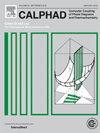多组分聚类变分法在高熵合金中的应用
IF 1.9
3区 材料科学
Q4 CHEMISTRY, PHYSICAL
Calphad-computer Coupling of Phase Diagrams and Thermochemistry
Pub Date : 2025-03-20
DOI:10.1016/j.calphad.2025.102825
引用次数: 0
摘要
团簇展开是计算热力学中常用的一种方法,它将合金的组态性质表示为相关函数与团簇展开系数的乘积和。在广义Ising模型从二元合金扩展到多组分合金的过程中,使用组态空间中的基来定义cec并不是唯一的,并且会发生变化。与CALPHAD的拟订方式相反,这一改变严重限制了以cec为基础的数据库的发展和使用。为了解决这个问题,引入了一个新的框架,其中低阶cec在高阶系统中保持不变。这是通过选择构型变量(和相应的CECs)来实现的,这些变量不依赖于作为相关函数(cf)的特定基的选择。这种集合由集群变量(CVs)提供,它表示各种类型的集群配置的比例。一个精心挑选的独立cv子集被选为cf。通过对无序bcc、fcc和hcp结构的新CFs导出所有剩余cv的表达式,证明了该基的完整性。采用这种新配方开发了一套用于Nb-Ti-V-Zr体系bcc相的cec。Nb-Ti-V-Zr的所有二、三元子系统的优化CECs已用于其构建。这是创建自一致计算热力学数据库的关键一步。通过计算热力学量、SRO参数和相图,证明了Nb-Ti-V-Zr数据库的实用性。此外,还概述了在某些假设下将现有CALPHAD数据库转换为基于cec的数据库的过程。本文章由计算机程序翻译,如有差异,请以英文原文为准。
Multicomponent cluster variation method: Application to high entropy alloys
Cluster expansion, a method commonly used in computational thermodynamics, expresses the configurational properties of alloys as a sum of products of correlation functions and cluster expansion coefficients (CECs). The CECs are defined using a basis in configurational space that is not unique and changes during the extension of the generalized Ising model from binary alloys to multicomponent alloys. In contrast to the CALPHAD formulation, this change severely restricts the development and use of CEC-based databases. To address this, a new framework is introduced where lower-order CECs remain unchanged in higher-order systems. This is achieved by choosing configurational variables (and corresponding CECs) which are not dependent on a particular choice of basis as correlation functions (CFs). Such a set is provided by cluster variables (CVs), which represent the fraction of cluster configurations of various types. A carefully selected subset of independent CVs is chosen as CFs. Completeness of the basis is demonstrated by deriving expressions for all remaining CVs in terms of these new CFs for disordered bcc, fcc, and hcp structures. A set of CECs for the bcc phase of the Nb-Ti-V-Zr system has been developed using this new formulation. Optimized CECs of all binary and ternary subsystems of the Nb-Ti-V-Zr have been used in its construction. This is a crucial step towards creating a self-consistent computational thermodynamics database. The utility of the Nb-Ti-V-Zr database was demonstrated through calculations of thermodynamic quantities, SRO parameters, and phase diagrams. Additionally, a procedure is outlined to transform existing CALPHAD databases to CEC-based databases under certain assumptions.
求助全文
通过发布文献求助,成功后即可免费获取论文全文。
去求助
来源期刊
CiteScore
4.00
自引率
16.70%
发文量
94
审稿时长
2.5 months
期刊介绍:
The design of industrial processes requires reliable thermodynamic data. CALPHAD (Computer Coupling of Phase Diagrams and Thermochemistry) aims to promote computational thermodynamics through development of models to represent thermodynamic properties for various phases which permit prediction of properties of multicomponent systems from those of binary and ternary subsystems, critical assessment of data and their incorporation into self-consistent databases, development of software to optimize and derive thermodynamic parameters and the development and use of databanks for calculations to improve understanding of various industrial and technological processes. This work is disseminated through the CALPHAD journal and its annual conference.

 求助内容:
求助内容: 应助结果提醒方式:
应助结果提醒方式:


